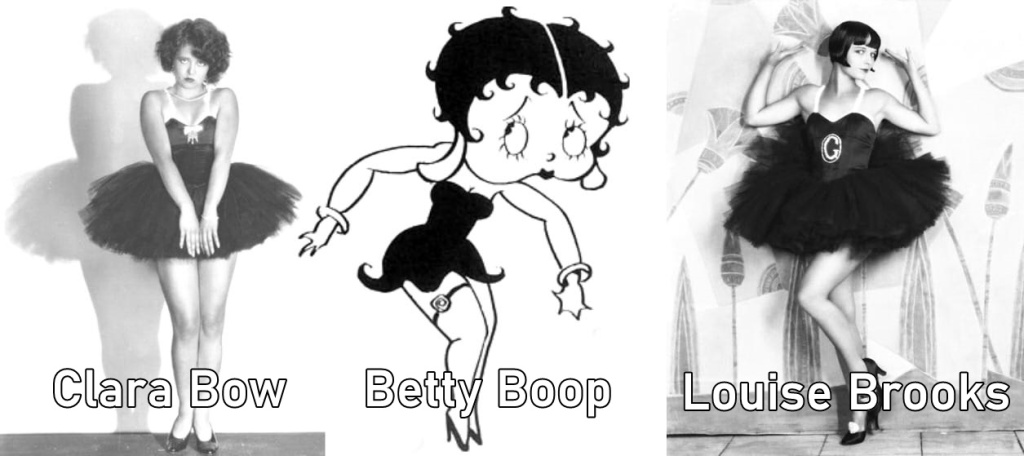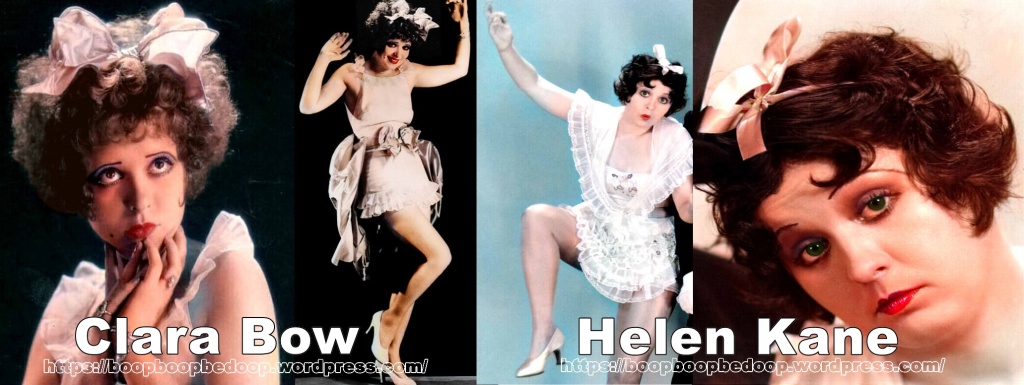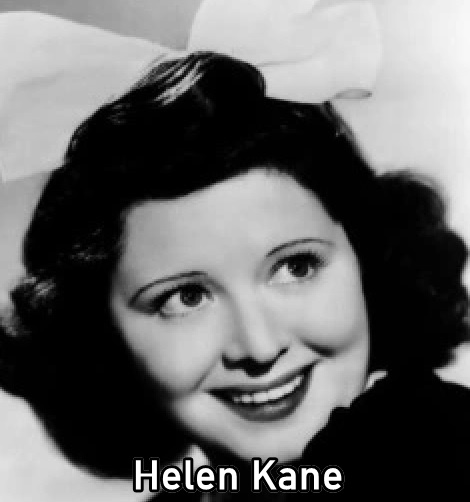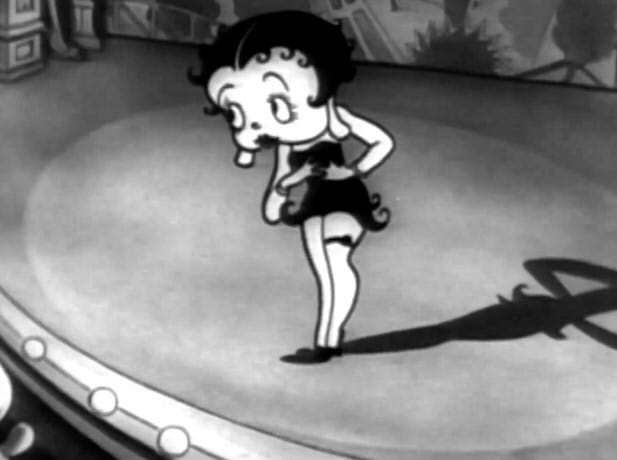
Who Inspired Betty Boop’s Outfit?
Someone recently asked me a question regarding Betty Boop’s dress.

(Sketch of Betty Boop in Silly Scandals by Grim Natwick.)
The outfits worn in 1929 by Louise Brooks and Clara Bow were said to have served as the model and or base for Betty’s newer frilly outfit that Betty debuted in the 1931 cartoon Silly Scandals.

Furthermore, Betty Boop’s hair color was influenced by Clara Bow’s hair color. The Fleischers when developing Betty, they didn’t just use “Helen Kane” they used many sources. Clara Bow being in all the Paramount news reports and magazines, would make her top priority.
In addition, there were risqué films featuring Bow and Betty Boop, both of whom were deemed risqué. Many jokes or allusions to risqué content, which is terrible for women. However, it is entertainment industry.
Since 1931, Betty had actually been a redhead. Grim Natwick drew the original Betty Boop with red hair and blue eyes.
But people who are not fans of the series or know very little of Betty’s origins really only saw Betty in black and white since she’s composed of ink. There’s a one-shot colorized “Betty Boop” cartoon called “Poor Cinderella” and that’s where Betty showcases her red hair.

Of course Betty looks better with black hair.
So yeah, people were unaware and still are to this day that Betty already was a redheaded character.

For those that do not know, Bow was honored by the “WAMPAS Baby Stars” campaign by the United States Western Association of Motion Picture Advertisers in 1924.
She inspired many girls and women to want to emulate her. A lot of these other women in the entertainment industry, they did not like Bow, and they did not think highly of Bow. Her being in public was frowned upon by rivals.
Helen Kane and Clara Bow, well they did not see eye-to-eye. Bow had already been established long before Kane was known. So Bow came before Kane.

Please note that Helen Kane was also known for wearing frilly baby-doll dresses with bows and frills, however in comparison the dresses she wore, they were more baggy and were not as sexy. Some of the dresses she wore in her earlier career looked awful.
Of course that gigantic ribbon on the back of Betty’s dress in Dizzy Dishes, obviously that was inspired by Kane’s dress in the 1929 film Pointed Heels, in which she also sported a ribbon on the back of her dress. However Betty had a more strapless dress, and Kane’s was hideously frilly but it looked like something that a baby would wear.
Being as Kane was a protégé of Bow, it would make Bow the originator. Therefore Bow was sort of the model for Betty Boop. The Fleischer Studios actually admitted to this several times throughout the 1930s.
However this was possibly because of the Helen Kane lawsuit. Kane was sort of mildly the base, but so were many other women. And Kane she wasn’t as original as she had claimed to have been.

Betty Boop and Clara Bow?
If you ever saw the 1933 Paramount Pictures live-action film Hollywood on Parade. The main protagonist is looking for a girlfriend, so he asks Rex Bell if he can date the famous Clara Bow.
Bow was obviously married to Bell, so he points in the direction of Max Fleischer’s girl Betty Boop, who in that short was portrayed by Bonnie Poe, who around this time was the age of 17 turning 18. Paramount was basically saying that Betty Boop is just like Clara Bow.
In this short, Betty’s dress seems more silky than frilly.
Poe’s real name was not Bonnie but also Clara.
So there was a Clara Bow and a Clara Poe.

Helen Kane vs. Clara Bow
Paul Ash confirmed in an early interview that Helen “Sugar” Kane was the new Clara Bow at one point. You probably wouldn’t believe this. After making her stage debut in 1928, Kane became incredibly popular in New York; but, by 1931, her stardom had faded. As it happened, Bow who was more well-known retired in 1933.


Unlike Kane, Bow frequently changed her hairstyle and at one point had really long hair. Kane didn’t grow her hair long until the late 1930s. I can see why they were rivals at one point.
And this explains why Kane was not very fond of Bow, as she saw Bow as tough competition. There is a lot of late-1920s and early-1930s gossip that actually validated this. I don’t think Kane hated Bow, but Kane had a little streak of jealousy. And anyone would, Bow was a real beauty.

Bow was the original jazz baby, however much like Madonna, she always reinvented herself. Bow debuted that frilly baby doll style years before Kane.

So ideally people know that Clara Bow had the exact same style as Kane, only Bow was more attractive and thin. This knowledge will be helpful when people see pictures of Kane looking a certain way or with ribbons in her hair.
But Kane, like a lot of other 1920s and 1930s flapper girls, did look like Bow. Given Kane’s plumper appearance, Kane is more easier to identify in vintage photos.


Kane was more or less a chubbier copy-cat, more plump. Kane pushed for the baby-doll style or persona because it differed to Bow. Kane obviously didn’t want to copy Bow to the extent of people catching on that she was trying to emulate Bow earlier on in her career. Thus, these two New Yorkers could be seen as relatively similar to one another.
Both of these vamps appeared in the 1930 film Paramount on Parade by Paramount Pictures. However Kane who had a tremendous following in New York was “furious” over Gloria Swanson’s statement saying that any one with half an eye could see that Clara Bow the “It” girl was the one real beauty among film stars.
So you have the “It Girl” and the “Boop-Boop-a-Doop Girl”.
And if you merge the both of them together, you have Betty Boop.
The Fleischers maintained and continue to maintain to this day that “no one” served as the model for Boop. But obviously they’ve tripped up a few times throughout the decades. And I personally won’t stand for lying or lies. In addition, Grim Natwick, who developed the “original” Betty in 1930, revealed the real story behind her creation.
Naturally, the Fleischers continued to develop Betty when Natwick left the studio. And so Betty ended up with the allure of Mae West, Greta Garbo and Marlene Dietrich, among other popular female stars of the 1930s.
Betty Boop is a sex-symbol, as was Clara Bow.
Who did Betty go on to emulate when she was rebooted during the 1980s? Another sex-symbol, and that was the famous Marilyn Monroe who become a more relevant icon than Clara Bow.
So there you have it.

In Betty Boop’s debut in 1930, her dress was not as frilly, however in Silly Scandals, Betty’s dress was intensely frilly. You probably can’t see the full preview in the model sheet, however you can in the animated cartoon.
Please look in the gallery below for a comparison.
Gallery:



